The State Administration Council organized the Waso robe-offering ceremony in 2025, in conjunction with the second anniversary of the successful consecration of the Maravijaya Buddha Image, held in the precincts of Maravijaya Buddha Park in Nay Pyi Taw yesterday morning.
The ceremony was attended by Chairman of the State Administration Council, Prime Minister Senior General Min Aung Hlaing and his wife, Daw Kyu Kyu Hla, who donated Waso robes and alms.
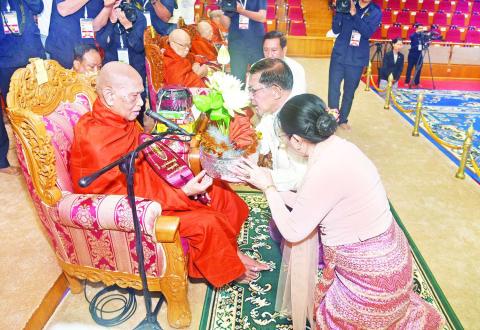
The State Administration Council organized the Waso robe-offering ceremony in 2025, in conjunction with the second anniversary of the successful consecration of the Maravijaya Buddha Image, held in the precincts of Maravijaya Buddha Park in Nay Pyi Taw yesterday morning.
The ceremony was attended by Chairman of the State Administration Council, Prime Minister Senior General Min Aung Hlaing and his wife, Daw Kyu Kyu Hla, who donated Waso robes and alms.
A total of 27 invited venerable members of the Sangha, including Ovadacariya Sayadaws from Uppatasanti Pagoda Board of Trustees, led by Chairman of the State Sangha Maha Nayaka Committee, Presiding Patron of Minkyaung Pahtamapyan Buddhism Learning Centre, Aggamaha Pandita, Aggamaha Saddhammajotikadhaja Dr Bhaddanta Candima Bhivamsa, SSMNC Secretary, Presiding Patron of Mandalay’s New Masoeyein Monastery, Dhammatheikdi Monastery Sayadaw Aggamaha Pandita, Aggamaha Saddhammajotikadhaja, Maha Dhammakathika Bahujanahitadhara Bhaddanta Vasettha Bhivamsa.
Before the ceremony, the Senior General offered alms, fruits, flowers, water and oil lamps to the Maravijaya Naungdawgyi Buddha Image in Aggadhipati Sasana Beikman Building.
The Senior General and the congregation took the Nine Precepts from the Chairman Sayadaw while members of the Sangha recited Metta Sutta.
Senior General Min Aung Hlaing and his wife Daw Kyu Kyu Hla offered Waso robes and alms to Thanlyin Minkyaung Sayadaw.
SAC Vice-Chairman, Deputy Prime Minister Vice-Senior General Soe Win and his wife Daw Than Than Nwe donated Waso robes and offertories to New Masoeyein Monastery Sayadaw. The Council Secretary and his wife, the Joint Secretary and his wife, SAC members and their wives and Union-level dignitaries presented Waso robes and offerings to members of the Sangha.
New Masoeyein Monastery Sayadaw delivered a sermon, while the congregation shared merits gained.
After the ceremony, the Senior General and all attendees offered lunch meals to members of the Sangha.
Also, present at the ceremony were Union ministers and their wives, the Nay Pyi Taw Council Chairman, senior Tatmadaw officers from the Office of the Commander-in-Chief and their wives, the commander of Nay Pyi Taw Command and officials. — MNA/TTA
GNLM
The State Administration Council organized the Waso robe-offering ceremony in 2025, in conjunction with the second anniversary of the successful consecration of the Maravijaya Buddha Image, held in the precincts of Maravijaya Buddha Park in Nay Pyi Taw yesterday morning.
The ceremony was attended by Chairman of the State Administration Council, Prime Minister Senior General Min Aung Hlaing and his wife, Daw Kyu Kyu Hla, who donated Waso robes and alms.
A total of 27 invited venerable members of the Sangha, including Ovadacariya Sayadaws from Uppatasanti Pagoda Board of Trustees, led by Chairman of the State Sangha Maha Nayaka Committee, Presiding Patron of Minkyaung Pahtamapyan Buddhism Learning Centre, Aggamaha Pandita, Aggamaha Saddhammajotikadhaja Dr Bhaddanta Candima Bhivamsa, SSMNC Secretary, Presiding Patron of Mandalay’s New Masoeyein Monastery, Dhammatheikdi Monastery Sayadaw Aggamaha Pandita, Aggamaha Saddhammajotikadhaja, Maha Dhammakathika Bahujanahitadhara Bhaddanta Vasettha Bhivamsa.
Before the ceremony, the Senior General offered alms, fruits, flowers, water and oil lamps to the Maravijaya Naungdawgyi Buddha Image in Aggadhipati Sasana Beikman Building.
The Senior General and the congregation took the Nine Precepts from the Chairman Sayadaw while members of the Sangha recited Metta Sutta.
Senior General Min Aung Hlaing and his wife Daw Kyu Kyu Hla offered Waso robes and alms to Thanlyin Minkyaung Sayadaw.
SAC Vice-Chairman, Deputy Prime Minister Vice-Senior General Soe Win and his wife Daw Than Than Nwe donated Waso robes and offertories to New Masoeyein Monastery Sayadaw. The Council Secretary and his wife, the Joint Secretary and his wife, SAC members and their wives and Union-level dignitaries presented Waso robes and offerings to members of the Sangha.
New Masoeyein Monastery Sayadaw delivered a sermon, while the congregation shared merits gained.
After the ceremony, the Senior General and all attendees offered lunch meals to members of the Sangha.
Also, present at the ceremony were Union ministers and their wives, the Nay Pyi Taw Council Chairman, senior Tatmadaw officers from the Office of the Commander-in-Chief and their wives, the commander of Nay Pyi Taw Command and officials. — MNA/TTA
GNLM
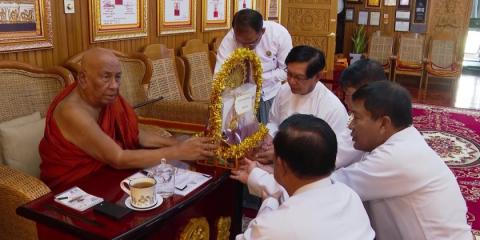
At the Sitagu Cakkhudana Advanced Eye Hospital, part of Sitagu Buddhist University (Yangon) in Dagon Myothit (North) Township, Yangon Region, free eye care services are being provided to patients from various regions. In this 13th round, approximately 1,700 patients came to receive the treatment.
At the Sitagu Cakkhudana Advanced Eye Hospital, part of Sitagu Buddhist University (Yangon) in Dagon Myothit (North) Township, Yangon Region, free eye care services are being provided to patients from various regions. In this 13th round, approximately 1,700 patients came to receive the treatment.
In the afternoon on July 7, Yangon Region Chief Minister U Soe Thein, along with region government members and officials, visited the hospital. They paid respects to Abhidhajamaharathaguru, Abhidhajaaggamahasaddhamma Jotika၊ Dr. Bhaddanta Ñāṇissara, the Sitagu Sayadaw, who is the Chancellor of Sitagu International Buddhist Academies, the Sangharaja of Shweykin Sect, and a highly revered religious figure with several titles.
The Chief Minister and officials donated offerings and financial contributions to support the treatment of eye patients and the purchase of essential medical equipment for surgical procedures.
Following that, the Chief Minister and officials encouraged the patients waiting for treatment, offering words of support.
It was reported that specialist ophthalmologists conducted examinations and treatments according to the specific eye conditions of each patient attending the program.
mitv
At the Sitagu Cakkhudana Advanced Eye Hospital, part of Sitagu Buddhist University (Yangon) in Dagon Myothit (North) Township, Yangon Region, free eye care services are being provided to patients from various regions. In this 13th round, approximately 1,700 patients came to receive the treatment.
In the afternoon on July 7, Yangon Region Chief Minister U Soe Thein, along with region government members and officials, visited the hospital. They paid respects to Abhidhajamaharathaguru, Abhidhajaaggamahasaddhamma Jotika၊ Dr. Bhaddanta Ñāṇissara, the Sitagu Sayadaw, who is the Chancellor of Sitagu International Buddhist Academies, the Sangharaja of Shweykin Sect, and a highly revered religious figure with several titles.
The Chief Minister and officials donated offerings and financial contributions to support the treatment of eye patients and the purchase of essential medical equipment for surgical procedures.
Following that, the Chief Minister and officials encouraged the patients waiting for treatment, offering words of support.
It was reported that specialist ophthalmologists conducted examinations and treatments according to the specific eye conditions of each patient attending the program.
mitv
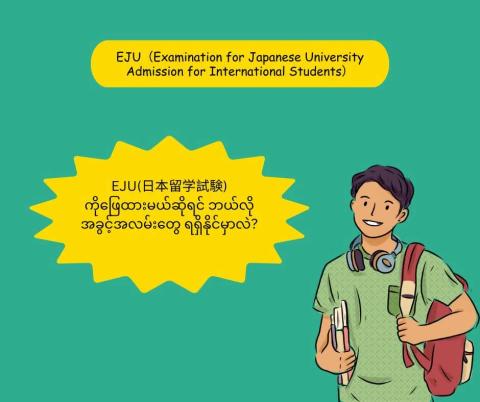
In order to hold the Examination for Japanese University Admission for International Students in November, applications are open starting from 7 July, said the Myanmar Association of Japan Alumni (MAJA).
In order to hold the Examination for Japanese University Admission for International Students in November, applications are open starting from 7 July, said the Myanmar Association of Japan Alumni (MAJA).
Exam fee is set as K60,000 for all subjects such as Japanese as a Foreign Language, Science or Japan and the World and Mathematics. For EJU, which is scheduled on 9 November, applications can be submitted as of 7 July at the MAJA Yangon head office and as of 10 July at the MAJA Mandalay branch. Applications will be accepted from 9:30 am to 4 pm during all weekdays, except public holidays and weekends, until the end of the month.
Three 3 by 4 centimetres licence-sized photos in blue or white background and a copy of the ID card are required. Candidates will have to fill the application form carefully, and no changes are allowed later, said MAJA.
EJU is a critical requirement for international students who have ambitions to study abroad as well as it is also an evaluation of the education level of the international students and can apply for admission to Japanese universities with EJU marks. — MT/ZS
GNLM
In order to hold the Examination for Japanese University Admission for International Students in November, applications are open starting from 7 July, said the Myanmar Association of Japan Alumni (MAJA).
Exam fee is set as K60,000 for all subjects such as Japanese as a Foreign Language, Science or Japan and the World and Mathematics. For EJU, which is scheduled on 9 November, applications can be submitted as of 7 July at the MAJA Yangon head office and as of 10 July at the MAJA Mandalay branch. Applications will be accepted from 9:30 am to 4 pm during all weekdays, except public holidays and weekends, until the end of the month.
Three 3 by 4 centimetres licence-sized photos in blue or white background and a copy of the ID card are required. Candidates will have to fill the application form carefully, and no changes are allowed later, said MAJA.
EJU is a critical requirement for international students who have ambitions to study abroad as well as it is also an evaluation of the education level of the international students and can apply for admission to Japanese universities with EJU marks. — MT/ZS
GNLM
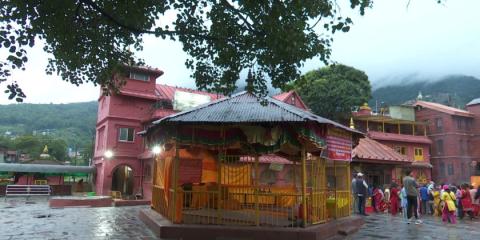
A large religious fair takes place at the revered Narayanthan Temple in Budhanilkantha, in the northern part of Nepal’s capital, Kathmandu. Thousands of Hindu devotees gathered to observe Harishayani Ekadashi festival, a holy day marking the beginning of the sacred four month period of devotion, fasting and spirituality.
A large religious fair takes place at the revered Narayanthan Temple in Budhanilkantha, in the northern part of Nepal’s capital, Kathmandu. Thousands of Hindu devotees gathered to observe Harishayani Ekadashi festival, a holy day marking the beginning of the sacred four month period of devotion, fasting and spirituality.
The Narayanthan Temple, home to a large reclining statue of Lord Bishnu is a major pilgrimage site. On this auspicious day, devotees from across the country and beyond offer prayers, and take part in various ritual. Harishayani Ekadashi falls on the 11th day of the waxing moon in the month of Ashad (June-July) according to the lunar calendar. This day also marks the symbolic beginning of Lord Bishnu’s four-month cosmic slumber, and the festival ends in November.
mitv
A large religious fair takes place at the revered Narayanthan Temple in Budhanilkantha, in the northern part of Nepal’s capital, Kathmandu. Thousands of Hindu devotees gathered to observe Harishayani Ekadashi festival, a holy day marking the beginning of the sacred four month period of devotion, fasting and spirituality.
The Narayanthan Temple, home to a large reclining statue of Lord Bishnu is a major pilgrimage site. On this auspicious day, devotees from across the country and beyond offer prayers, and take part in various ritual. Harishayani Ekadashi falls on the 11th day of the waxing moon in the month of Ashad (June-July) according to the lunar calendar. This day also marks the symbolic beginning of Lord Bishnu’s four-month cosmic slumber, and the festival ends in November.
mitv

Turkish Presidency of Religious Affairs called for divine intervention to help extinguish the flames. In the face of on-going wildfires across several regions of Turkiye, particularly in the Aegean, the Presidency of Religious Affairs organized nationwide prayers on Saturday night, calling for divine intervention to help extinguish the flames. Following the Isha prayer, special prayers were held simultaneously in all 81 provinces of the country.
mitv
Turkish Presidency of Religious Affairs called for divine intervention to help extinguish the flames. In the face of on-going wildfires across several regions of Turkiye, particularly in the Aegean, the Presidency of Religious Affairs organized nationwide prayers on Saturday night, calling for divine intervention to help extinguish the flames. Following the Isha prayer, special prayers were held simultaneously in all 81 provinces of the country.
mitv
Turkish Presidency of Religious Affairs called for divine intervention to help extinguish the flames. In the face of on-going wildfires across several regions of Turkiye, particularly in the Aegean, the Presidency of Religious Affairs organized nationwide prayers on Saturday night, calling for divine intervention to help extinguish the flames. Following the Isha prayer, special prayers were held simultaneously in all 81 provinces of the country.
mitv
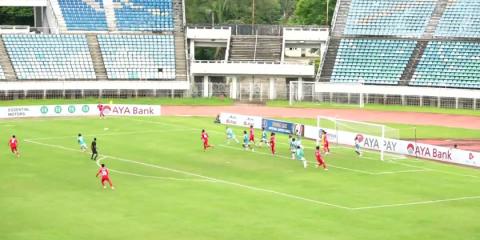
Chairman of Myanmar Olympic Committee and Union Minister for Sports and Youth Affairs Jeng Phang Naw Taung, together with officials, on 5th July arrived at football ground in Dagon MyoThit (South) of Yangon.
He instructed officials to make well-preparation for organizing U-18 Football competition, ensuring the betterment of goalpost, net and substitute benches. The Union Minister later viewed the Taekwondo practicing, and encouraged the players.
Chairman of Myanmar Olympic Committee and Union Minister for Sports and Youth Affairs Jeng Phang Naw Taung, together with officials, on 5th July arrived at football ground in Dagon MyoThit (South) of Yangon.
He instructed officials to make well-preparation for organizing U-18 Football competition, ensuring the betterment of goalpost, net and substitute benches. The Union Minister later viewed the Taekwondo practicing, and encouraged the players.
At the Multipurpose Stadium in Dagon MyoThit (South), the Union Minister and party inspected the stadium and called on to keep cleaning and beautifying, with systematic maintenance of the buildings. The Union Minister then proceeded to Myanmar Paralympic Sports Federation where he met with athletes who are camping for 13th ASEAN Para Games.
During the meeting, the Union Minister instructed to strive for meeting the standards with unity and to win medals for the nation. He also enjoyed the practicing of sitting-vollyball. The Union Minister then inspected the mess hall where officials reported current status and purchasing of aids and prothestics.
On July 6th, the Union Minister visited the Padonmar Stadium in Sanchaung Township to inspect the football ground and instructed the necessaries. The Union Minister and party also visited the Thuwana football ground where they enjoyed the final match of MNL League Cup 2025.
Yangon United won the championship after defeating Shan United with 1-0 score. After the match, Union Minister, Yangon Region Chief Minister and officials presented trophy, cash awards aand medals to winning teams and individuals.
mitv
Chairman of Myanmar Olympic Committee and Union Minister for Sports and Youth Affairs Jeng Phang Naw Taung, together with officials, on 5th July arrived at football ground in Dagon MyoThit (South) of Yangon.
He instructed officials to make well-preparation for organizing U-18 Football competition, ensuring the betterment of goalpost, net and substitute benches. The Union Minister later viewed the Taekwondo practicing, and encouraged the players.
At the Multipurpose Stadium in Dagon MyoThit (South), the Union Minister and party inspected the stadium and called on to keep cleaning and beautifying, with systematic maintenance of the buildings. The Union Minister then proceeded to Myanmar Paralympic Sports Federation where he met with athletes who are camping for 13th ASEAN Para Games.
During the meeting, the Union Minister instructed to strive for meeting the standards with unity and to win medals for the nation. He also enjoyed the practicing of sitting-vollyball. The Union Minister then inspected the mess hall where officials reported current status and purchasing of aids and prothestics.
On July 6th, the Union Minister visited the Padonmar Stadium in Sanchaung Township to inspect the football ground and instructed the necessaries. The Union Minister and party also visited the Thuwana football ground where they enjoyed the final match of MNL League Cup 2025.
Yangon United won the championship after defeating Shan United with 1-0 score. After the match, Union Minister, Yangon Region Chief Minister and officials presented trophy, cash awards aand medals to winning teams and individuals.
mitv
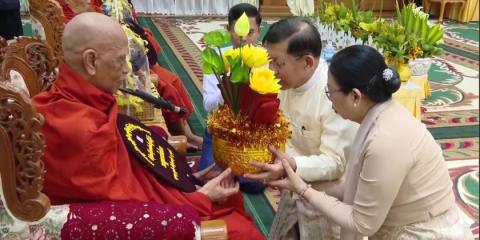
Waso robe offering ceremony was organized by families of the office of Commander-in-Chife (Army, Navy and Air) on 6th of July with the attandance of Chairman of the State Administration Council, Commander-in-Chief of Defence Services Senior General Min Aung Hlaing and wife.
Waso robe offering ceremony was organized by families of the office of Commander-in-Chife (Army, Navy and Air) on 6th of July with the attandance of Chairman of the State Administration Council, Commander-in-Chief of Defence Services Senior General Min Aung Hlaing and wife.
First, the Senior General paid homage to the Buddha Image and offered alms, flower, water and oil light. Then, the congregation led by the Senior General received the nine precepts from the Chairman of the State Sangha Maha Nayaka Committee, Presiding Sayadaw of Thanlyin Min Kyaung Monastery, and listened to the sermons delivered by the Sayadaws.
After that, the Senior General and wife donated waso robe and offertories to the Thanlyin Minkyaung Sayadaw. This was followed by donation of waso robes and offortories to the Sayadaws by Vice Chairman of the State Administration Council Deputy Commander-in-Chief of Defence Services, Commander-in-Chief (Army) Vice Senior General Soe Win and wife and attendees.
After delivering a sermon by the Masoeyein TaikThit Monastery Sayadawgyi, the congregation shared the merits gained. After the ceremony, the Senior General and wife, the Vice-Senior General and wife, and senior military officers offered day meals to the Sayadaws and members of the Sangha.
mitv
Waso robe offering ceremony was organized by families of the office of Commander-in-Chife (Army, Navy and Air) on 6th of July with the attandance of Chairman of the State Administration Council, Commander-in-Chief of Defence Services Senior General Min Aung Hlaing and wife.
First, the Senior General paid homage to the Buddha Image and offered alms, flower, water and oil light. Then, the congregation led by the Senior General received the nine precepts from the Chairman of the State Sangha Maha Nayaka Committee, Presiding Sayadaw of Thanlyin Min Kyaung Monastery, and listened to the sermons delivered by the Sayadaws.
After that, the Senior General and wife donated waso robe and offertories to the Thanlyin Minkyaung Sayadaw. This was followed by donation of waso robes and offortories to the Sayadaws by Vice Chairman of the State Administration Council Deputy Commander-in-Chief of Defence Services, Commander-in-Chief (Army) Vice Senior General Soe Win and wife and attendees.
After delivering a sermon by the Masoeyein TaikThit Monastery Sayadawgyi, the congregation shared the merits gained. After the ceremony, the Senior General and wife, the Vice-Senior General and wife, and senior military officers offered day meals to the Sayadaws and members of the Sangha.
mitv
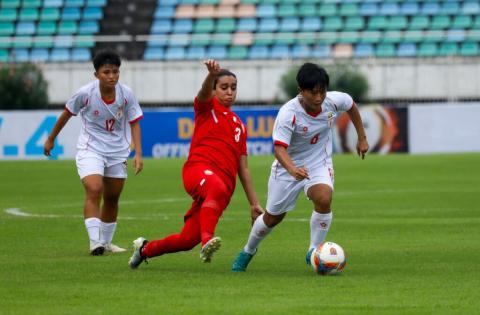
Myanmar’s women’s national football team earned a resounding 6-0 win over Bahrain in their final Group C match of the AFC Women’s Asian Cup 2026 qualifiers, held on 5 July at Thuwunna Youth Training Centre in Yangon.
Despite being eliminated from qualification after their earlier 1-2 loss to Bangladesh, the hosts finished their campaign with a dominant performance.
Myanmar’s women’s national football team earned a resounding 6-0 win over Bahrain in their final Group C match of the AFC Women’s Asian Cup 2026 qualifiers, held on 5 July at Thuwunna Youth Training Centre in Yangon.
Despite being eliminated from qualification after their earlier 1-2 loss to Bangladesh, the hosts finished their campaign with a dominant performance.
Head coach Yuki reintroduced key striker Win Theingi Tun into the starting line-up, supported by Phyu Phyu Win, Khin Mo Mo Tun, May Htet Lu and San Thaw Thaw. Myanmar dominated possession from kick-off but opened the scoring only in 39 minutes. The team netted three goals in each half.
Goal scorers for Myanmar were Shwe Yi Htun in 39 minutes and 42 minutes, Khin Mo Mo Tun in 45+5 minutes, Win Theingi Tun in 52 minutes, May Htet Lu in 58 minutes, and Win Win in 73 minutes.
In the group’s other match, Bangladesh crushed Turkmenistan 7-0 to top Group C with nine points and secure qualification. Myanmar finished second with six points, while Bahrain and Turkmenistan ended with just one point each and failed to advance. — Chit Ko Ko/KZL
GNLM
Myanmar’s women’s national football team earned a resounding 6-0 win over Bahrain in their final Group C match of the AFC Women’s Asian Cup 2026 qualifiers, held on 5 July at Thuwunna Youth Training Centre in Yangon.
Despite being eliminated from qualification after their earlier 1-2 loss to Bangladesh, the hosts finished their campaign with a dominant performance.
Head coach Yuki reintroduced key striker Win Theingi Tun into the starting line-up, supported by Phyu Phyu Win, Khin Mo Mo Tun, May Htet Lu and San Thaw Thaw. Myanmar dominated possession from kick-off but opened the scoring only in 39 minutes. The team netted three goals in each half.
Goal scorers for Myanmar were Shwe Yi Htun in 39 minutes and 42 minutes, Khin Mo Mo Tun in 45+5 minutes, Win Theingi Tun in 52 minutes, May Htet Lu in 58 minutes, and Win Win in 73 minutes.
In the group’s other match, Bangladesh crushed Turkmenistan 7-0 to top Group C with nine points and secure qualification. Myanmar finished second with six points, while Bahrain and Turkmenistan ended with just one point each and failed to advance. — Chit Ko Ko/KZL
GNLM
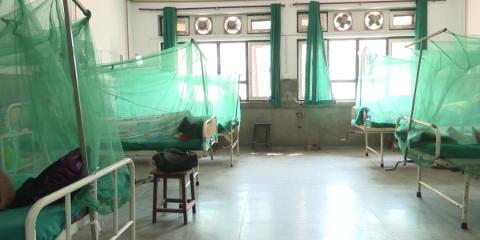
The risk of dengue is increasing rapidly in Nepal, with cases peaking in June, according to the Epidemiology and Disease Control Division. So far, 1,677 cases have been recorded over the past six months. Doctors warn that dengue poses greater risks to children, pregnant and lactating women, the elderly, and obese individuals, and advise immediate testing if symptoms like high fever, nausea, or muscle pain appear.
The risk of dengue is increasing rapidly in Nepal, with cases peaking in June, according to the Epidemiology and Disease Control Division. So far, 1,677 cases have been recorded over the past six months. Doctors warn that dengue poses greater risks to children, pregnant and lactating women, the elderly, and obese individuals, and advise immediate testing if symptoms like high fever, nausea, or muscle pain appear.
A Consultant Physician notes that while most patients recover at home, severe cases may require urgent hospital care due to complications like bleeding, vomiting, and dehydration.
mitv
The risk of dengue is increasing rapidly in Nepal, with cases peaking in June, according to the Epidemiology and Disease Control Division. So far, 1,677 cases have been recorded over the past six months. Doctors warn that dengue poses greater risks to children, pregnant and lactating women, the elderly, and obese individuals, and advise immediate testing if symptoms like high fever, nausea, or muscle pain appear.
A Consultant Physician notes that while most patients recover at home, severe cases may require urgent hospital care due to complications like bleeding, vomiting, and dehydration.
mitv
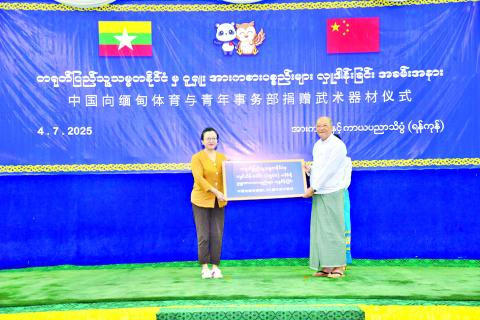
A handover ceremony for Wushu sports equipment donated by the People’s Republic of China to the Ministry of Sports and Youth Affairs was held at 10 am on 4 July at the Institute of Sports and Physical Education (Yangon) located at Kyaikkasan Sports Grounds, Tamway Township, Yangon Region.
A handover ceremony for Wushu sports equipment donated by the People’s Republic of China to the Ministry of Sports and Youth Affairs was held at 10 am on 4 July at the Institute of Sports and Physical Education (Yangon) located at Kyaikkasan Sports Grounds, Tamway Township, Yangon Region.
Union Minister for Sports and Youth Affairs and Chairperson of the Myanmar Olympic Committee Jeng Phang Naw Taung, Yangon Region Chief Minister U Soe Thein, Chinese Ambassador to Myanmar Ms Ma Jia and officials from the Chinese Embassy, regional ministers, senior officials from the Department of Sports and Physical Education and the Myanmar Wushu Federation, along with guests attended the ceremony.
At the event, Chinese Ambassador Ms Ma Jia delivered a speech highlighting the purpose and significance of the donation. Union Minister U Jeng Phang Naw Taung followed by expressing appreciation for China’s continued support in the sports sector. He noted that Myanmar’s achievements in Wushu, such as consistent medal wins at the Asian Games, Southeast Asian Games, and other international competitions, had been made possible through joint training programmes, deployment of international coaches, and material support from China.
Following the speeches, Ambassador Ms Ma Jia formally handed over the donated Wushu equipment to the Union minister, who, in return, presented a certificate of appreciation.
After the handover, the Union minister held bilateral discussions with Ambassador Ma Jia on strengthening cooperation in sports development, including the utilization of financial budgets in 2026-2027 for advancing Myanmar’s athletic performance, particularly in regional events such as the Southeast Asian Games and Asian Games.
Later, the Union minister visited the Teqball Training Hall within the Kyaikkasan sports complex to inspect training activities. Teqball athletes currently preparing for the XXXIII Southeast Asian Games showcased their training, and he provided guidance on performance improvement and coaching strategies.
In the afternoon, the Union minister attended the opening ceremony of the 2025 Inter-State/Region U18 Track and Field Championships at the Padetha Stadium in South Okkalapa Township, Yangon. He delivered opening remarks encouraging young athletes and underscored the importance of sports discipline.
Athletes then recited the four-point oath of sportsmanship. Subsequently, the Yangon Region chief minister awarded incentive cash prizes to the combined teams of Basic Education High School 1 Latha and music troops.
The opening ceremony concluded with enthusiastic support for the boys’ and girls’ 4 by 100 metres relay events. — MNA/KZL
GNLM
A handover ceremony for Wushu sports equipment donated by the People’s Republic of China to the Ministry of Sports and Youth Affairs was held at 10 am on 4 July at the Institute of Sports and Physical Education (Yangon) located at Kyaikkasan Sports Grounds, Tamway Township, Yangon Region.
Union Minister for Sports and Youth Affairs and Chairperson of the Myanmar Olympic Committee Jeng Phang Naw Taung, Yangon Region Chief Minister U Soe Thein, Chinese Ambassador to Myanmar Ms Ma Jia and officials from the Chinese Embassy, regional ministers, senior officials from the Department of Sports and Physical Education and the Myanmar Wushu Federation, along with guests attended the ceremony.
At the event, Chinese Ambassador Ms Ma Jia delivered a speech highlighting the purpose and significance of the donation. Union Minister U Jeng Phang Naw Taung followed by expressing appreciation for China’s continued support in the sports sector. He noted that Myanmar’s achievements in Wushu, such as consistent medal wins at the Asian Games, Southeast Asian Games, and other international competitions, had been made possible through joint training programmes, deployment of international coaches, and material support from China.
Following the speeches, Ambassador Ms Ma Jia formally handed over the donated Wushu equipment to the Union minister, who, in return, presented a certificate of appreciation.
After the handover, the Union minister held bilateral discussions with Ambassador Ma Jia on strengthening cooperation in sports development, including the utilization of financial budgets in 2026-2027 for advancing Myanmar’s athletic performance, particularly in regional events such as the Southeast Asian Games and Asian Games.
Later, the Union minister visited the Teqball Training Hall within the Kyaikkasan sports complex to inspect training activities. Teqball athletes currently preparing for the XXXIII Southeast Asian Games showcased their training, and he provided guidance on performance improvement and coaching strategies.
In the afternoon, the Union minister attended the opening ceremony of the 2025 Inter-State/Region U18 Track and Field Championships at the Padetha Stadium in South Okkalapa Township, Yangon. He delivered opening remarks encouraging young athletes and underscored the importance of sports discipline.
Athletes then recited the four-point oath of sportsmanship. Subsequently, the Yangon Region chief minister awarded incentive cash prizes to the combined teams of Basic Education High School 1 Latha and music troops.
The opening ceremony concluded with enthusiastic support for the boys’ and girls’ 4 by 100 metres relay events. — MNA/KZL
GNLM

